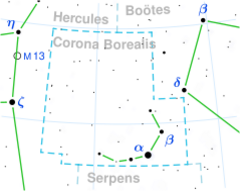Astronomy:Lambda Coronae Borealis
| Observation data Equinox J2000.0]] (ICRS) | |
|---|---|
| Constellation | Corona Borealis |
| Right ascension | 15h 55m 47.58774s[1] |
| Declination | +37° 56′ 49.0397″[1] |
| Apparent magnitude (V) | 5.43[2] |
| Characteristics | |
| Spectral type | F2 IV-V[3] |
| U−B color index | +0.01[4] |
| B−V color index | +0.352±0.004[2] |
| Astrometry | |
| Radial velocity (Rv) | −11.6±0.8[5] km/s |
| Proper motion (μ) | RA: 29.099[1] mas/yr Dec.: 79.528[1] mas/yr |
| Parallax (π) | 24.0631 ± 0.0890[1] mas |
| Distance | 135.5 ± 0.5 ly (41.6 ± 0.2 pc) |
| Absolute magnitude (MV) | +2.34[6] |
| Details[7] | |
| Mass | 1.60±0.02 M☉ |
| Radius | 2.13+0.13 −0.02[1] R☉ |
| Luminosity | 9.382±0.046[1] L☉ |
| Surface gravity (log g) | 4.05±0.02 cgs |
| Temperature | 6,991±63 K |
| Metallicity [Fe/H] | 0.00±0.05 dex |
| Rotational velocity (v sin i) | 75.7±3.8[8] km/s |
| Age | 1.42+0.08 −0.20 Gyr |
| Other designations | |
| Database references | |
| SIMBAD | data |
Lambda Coronae Borealis, its name Latinised from λ Coronae Borealis, is a single[10] star in the northern constellation of Corona Borealis. In publications it is also identified as HR 5936 and HD 142908. It has a yellow-white hue and is dimly visible to the naked eye with an apparent visual magnitude of 5.43.[2] The star is located at a distance of 136 light years based on parallax,[1] but is drifting closer with a radial velocity of −12 km/s.[5]
The stellar classification of Lambda Coronae Borealis is F2 IV-V,[3] which means it is somewhat hotter than the sun and shows spectral features intermediate between a main sequence and subgiant star. It has an estimated age of 1.4 billion years with a relatively high projected rotational velocity of 76 km/s.[8] The star has 1.6[7] times the mass of the Sun and 2.1[1] times the Sun's radius. Based on the amount of iron in the atmosphere, the elemental abundances are similar to those in the Sun.[7] It is radiating 9.4[1] times the luminosity of the Sun from its photosphere at an effective temperature of 6,991 K.[7]
The star displays an infrared excess with a signature that indicates a pair of circumstellar disks of dusty debris are orbiting the star. A blackbody fit to the higher temperature signal gives a temperature of 320 K with an orbital distance of 2.20 astronomical unit|AU. The cooler outer disk is orbiting 144.07 AU from the star with a temperature of 40 K.[11]
A magnitude 11.44 visual companion was discovered by W. Herschel in 1782. As of 2015, it was located at an angular separation of 90.6″ from the brighter component, along a position angle of 68°.[12]
References
- ↑ 1.0 1.1 1.2 1.3 1.4 1.5 1.6 1.7 1.8 1.9 Brown, A. G. A. (August 2018). "Gaia Data Release 2: Summary of the contents and survey properties". Astronomy & Astrophysics 616: A1. doi:10.1051/0004-6361/201833051. Bibcode: 2018A&A...616A...1G. Gaia DR2 record for this source at VizieR.
- ↑ 2.0 2.1 2.2 Anderson, E.; Francis, Ch. (2012). "XHIP: An extended hipparcos compilation". Astronomy Letters 38 (5): 331. doi:10.1134/S1063773712050015. Bibcode: 2012AstL...38..331A.
- ↑ 3.0 3.1 Gray, R. O. et al. (2001). "The Physical Basis of Luminosity Classification in the Late A-, F-, and Early G-Type Stars. II. Basic Parameters of Program Stars and the Role of Microturbulence". The Astronomical Journal 121 (4): 2159. doi:10.1086/319957. Bibcode: 2001AJ....121.2159G.
- ↑ Mermilliod, J.-C. (1986). "Compilation of Eggen's UBV data, transformed to UBV (unpublished)". Catalogue of Eggen's UBV Data. Bibcode: 1986EgUBV........0M.
- ↑ 5.0 5.1 Gontcharov, G. A. (2006). "Pulkovo Compilation of Radial Velocities for 35 495 Hipparcos stars in a common system". Astronomy Letters 32 (11): 759–771. doi:10.1134/S1063773706110065. Bibcode: 2006AstL...32..759G.
- ↑ Holmberg, J. et al. (2009). "The Geneva-Copenhagen survey of the solar neighbourhood. III. Improved distances, ages, and kinematics". Astronomy and Astrophysics 501 (3): 941. doi:10.1051/0004-6361/200811191. Bibcode: 2009A&A...501..941H.
- ↑ 7.0 7.1 7.2 7.3 Aguilera-Gómez, Claudia et al. (June 2018). "Lithium abundance patterns of late-F stars: an in-depth analysis of the lithium desert". Astronomy & Astrophysics 614: 15. doi:10.1051/0004-6361/201732209. A55. Bibcode: 2018A&A...614A..55A.
- ↑ 8.0 8.1 Ammler-von Eiff, Matthias; Reiners, Ansgar (June 2012), "New measurements of rotation and differential rotation in A-F stars: are there two populations of differentially rotating stars?", Astronomy & Astrophysics 542: A116, doi:10.1051/0004-6361/201118724, Bibcode: 2012A&A...542A.116A.
- ↑ "lam CrB". SIMBAD. Centre de données astronomiques de Strasbourg. http://simbad.u-strasbg.fr/simbad/sim-basic?Ident=lam+CrB.
- ↑ Eggleton, P. P.; Tokovinin, A. A. (September 2008). "A catalogue of multiplicity among bright stellar systems". Monthly Notices of the Royal Astronomical Society 389 (2): 869–879. doi:10.1111/j.1365-2966.2008.13596.x. Bibcode: 2008MNRAS.389..869E.
- ↑ Cotten, Tara H.; Song, Inseok (July 2016). "A Comprehensive Census of Nearby Infrared Excess Stars". The Astrophysical Journal Supplement Series 225 (1): 24. doi:10.3847/0067-0049/225/1/15. 15. Bibcode: 2016ApJS..225...15C.
- ↑ Mason, B. D. et al. (2014). "The Washington Visual Double Star Catalog". The Astronomical Journal 122 (6): 3466. doi:10.1086/323920. Bibcode: 2001AJ....122.3466M.
 |


